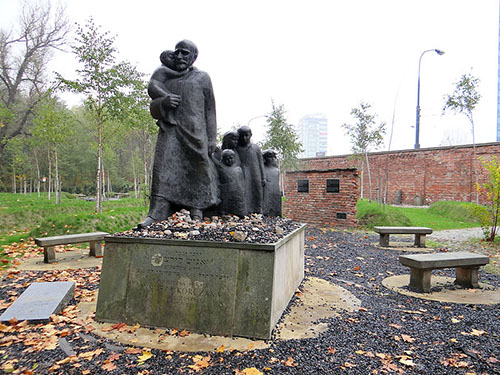It’s not just a tourist destination. It’s destroyed lives. It’s broken families. It’s fragmented lifetimes and unfulfilled potentials. But you wouldn’t know. Because tour groups traipse along the wide, sunny path, because children leap over train tracks, because life rings through the air. Two million people visit Auschwitz-Birkenau Concentration Camp every year. During the summer of 2019, I was one of them.
Selected among 15 other teenagers to participate in Holocaust Legacy Fellows, a program that gave us the chance to travel to Poland and Germany to learn how to counter growing Holocaust denial and anti-Semitism around the world, I saw more than any textbook could teach. I saw dusty shoes piled to the ceiling; I saw hundreds of abandoned combs and brushes; I saw articles of clothing echoing with the ghosts of those who used to wear them; I saw tiny bunk beds on which eight to twelve people slept at a time; I saw memorials; I saw human ash; I saw photographs; I saw barracks — and the people around me did too.
But people at home hadn’t seen it. 45 percent of Americans cannot name a single concentration camp. 41 percent of millenials believe that two million or fewer people died during the Holocaust. Our failure to preserve the memory of one of the most horrific representations of human evil, one that occurred less than 80 years ago, has reduced this genocide to the pages of a history textbook.
But worse than forgetting the Holocaust is continuing it. And in recent years, a staggering number of people seem to be intent on bringing the brutalities of the past right to the present.
The perpetrators of the vandalization of a Holocaust memorial in Ukraine hadn’t seen what I saw either. The person who assaulted and robbed a Hasidic Jewish man in Brooklyn hadn’t seen it. The student who hung a swastika in a Jewish classmate’s room at Tufts University hadn’t seen it. The white supremacist who shot up the Tree of Life synagogue in Pittsburgh hadn’t seen it. And I’m convinced that if they had seen what I saw during my time in the place where the Holocaust occurred, they just wouldn’t care. So while the problem of growing hatred against Jews and disregard for the Holocaust may originate almost entirely in vile anti-Semites who have practically destroyed the memory of this genocide, the solution lies with those who have simply forgotten.
Anti-Semitism is, for the most part, permanant. Forgetting, though, is entirely reversible. Memory can be perfectly restored by the dissemination of information; all you need is people who have the information and those willing and open to receive it. Prior to the Holocaust Legacy Fellows program, I was not qualified to spread information about the Holocaust. My relationship to the Holocaust was composed entirely of numbers. This many people died, this many survived, this many still live today… I didn’t see the problem with this form of education until I realized the dehumanizing power held within a number. Hundreds of thousands of Jews were stripped of their identities in Auschwitz-Birkenau and tattooed with a serial number that would effectively replace their names. Human beings were killed because the number of years they had been alive did not fall within the range of ages considered ‘suitable for work.’ In the concentration camps, prisoners were always lined up in fives, as though they were goods being arranged for sale. Just 80 years ago, millions of people were treated as nothing more than ‘units’ by members of a depraved ideology; and the world stood by and watched.
But the Holocaust was not a story of numbers. It was a story of stories. And Holocaust Legacy Fellows gifted me the chance to morph a distant relationship to the numbers of the Holocaust into a real, human, unbreakable connection to the stories. In the Warsaw Cemetery, I learned about Janusz Korczak, a director of an orphanage in Warsaw who could have saved himself when all his orphans were sent to Treblinka extermination camp, but who refused to let the children go alone. In a Christian cemetery in Poland, I learned about the Ulma family, Christians who were executed for their efforts to rescue and hide Jews from the Nazis. In Zbylitowska Gura, I learned about the 800 Jewish children who were separated from their parents and killed in an unmarked, mass grave in the middle of a forest, and I saw that grave for myself. Walking through the place where their lives were mercilessly destroyed, I learned about the millions of my people who I used to only know in numbers, all with only a fragment of a lifetime full of stories to tell.
Now that I have the stories, it is my obligation to spread them. Because numbers are not enough. We’re alive. We have names, and personalities, and stories. We’re human. We feel the grief and relief and hurt and joy that are so intrinsically tied to our humanity. We’re not numbers. We’re not statistics. We’re not unmarked graves. And neither were they. But because they are not here to tell people “I was here. I have a name. This is what happened to me,” we must do it for them. I am so lucky to have been able to travel to Poland and Germany to see beyond the numbers of a genocide that took place less than a century ago. If you have the chance to do so as well, I highly recommend it. But if not, learn as much as you can about the Holocaust; not just the numbers, but the stories as well. Because we didn’t survive just to forget them. They are part of us, living in every one of our actions, trusting us to rehumanize them and to keep their stories alive. Let’s not betray that trust.

